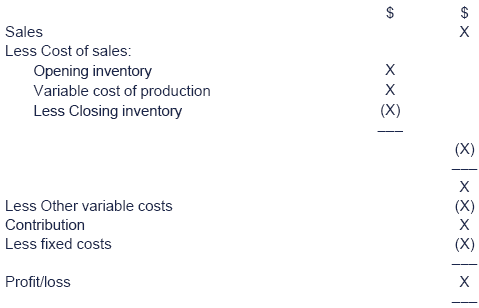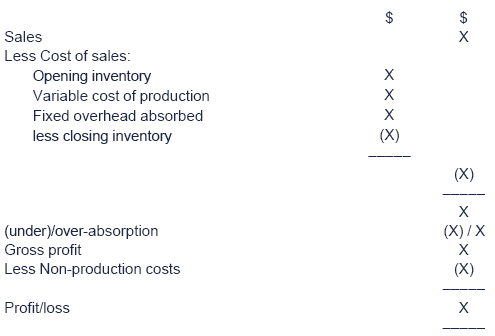Marginal and absorption costing
Marginal and absorption costing are two different approaches to dealing with fixed production overheads and whether or not they are included in valuing inventory.
Marginal costing
Basic idea
The marginal cost of an item is its variable cost. The marginal production cost of an item is the sum of its direct materials cost, direct labour cost, direct expenses cost (if any) and variable production overhead cost. So as the volume of production and sales increases total variable costs rise proportionately.
Fixed costs, in contrast are cost that remain unchanged in a time period, regardless of the volume of production and sale.
Marginal production cost is the part of the cost of one unit of production service which would be avoided if that unit were not produced, or which would increase if one extra unit were produced.
From this we can develop the following definition of marginal costing as used in management accounting:
Marginal costing is the accounting system in which variable costs are charged to cost units and fixed costs of the period are written off in full against the aggregate contribution.
Note that variable costs are those which change as output changes - these are treated under marginal costing as costs of the product. Fixed costs, in this system, are treated as costs of the period.
Marginal costing is also the principal costing technique used in decision making. The key reason for this is that the marginal costing approach allows management's attention to be focussed on the changes which result from the decision under consideration.
The contribution concept

The contribution concept lies at the heart of marginal costing. Contribution can be calculated as follows.
Contribution = Sales price - Variable costs
The idea of profit is not a particularly useful one as it depends on how many units are sold. For this reason, the contribution concept is frequently employed by management accountants.
- Contribution gives an idea of how much 'money' there is available to 'contribute' towards paying for the overheads of the organisation.
- At varying levels of output and sales, contribution per unit is constant.
- At varying levels of output and sales, profit per unit varies.
- Total contribution = Contribution per unit x Sales volume.
- Profit = Total contribution - Fixed overheads
Marginal costing income statement

- Valuation of inventory - opening and closing inventory are valued at marginal (variable) cost under marginal costing.
- The fixed costs actually incurred are deducted from contribution earned in order to determine the profit for the period.
Absorption costing
Basic idea
The principles of absorption costing are discussed in more detail on the page Overheads.
Absorption costing is a method of building up a full product cost which adds direct costs and a proportion of production overhead costs by means of one or a number of overhead absorption rates.
Absorption costing income statement

- Valuation of inventory - opening and closing inventory are valued at full production cost under absorption costing.
- Under/over-absorbed overhead - an adjustment for under or over absorption of overheads is necessary in absorption costing income statements.
Your FeedbackWe value your feedback on the topics or anything else you have found on our site, so we can make it even better.Give Feedback The effect of absorption and marginal costing on inventory valuation and profit determination
Marginal costing values inventory at the total variable production cost of a unit of product.
Absorption costing values inventory at the full production cost of a unit of product.
- Inventory values will therefore be different at the beginning and end of a period under marginal and absorption costing.
- If inventory values are different, then this will have an effect on profits reported in the income statement in a period. Profits determined using marginal costing principles will therefore be different to those using absorption costing principles.
Reconciling profits reported under the different methods
When inventory levels increase or decrease during a period then profits differ under absorption and marginal costing.
- If inventory levels increase, absorption costing gives the higher profit.
This is because fixed overheads held in closing inventory are carried forward (thereby reducing cost of sales) to the next accounting period instead of being written off in the current accounting period (as a period cost, as in marginal costing).
- If inventory levels decrease, marginal costing gives the higher profit.
This is because fixed overhead brought forward in opening inventory is released, thereby increasing cost of sales and reducing profits.
- If inventory levels are constant, both methods give the same profit.
The advantages and disadvantages of absorption and marginal costing
| Advantages of marginal costing | Advantages of absorption costing |
- Contribution per unit is constant unlike profit per unit which varies with changes in sales volumes
- There is no under or over absorption of overheads (and hence no adjustment is required in the income statement).
- Fixed costs are a period cost and are charged in full to the period under consideration
- Marginal costing is useful in the decision-making process
- It is simple to operate
| - Absorption costing includes an element of fixed overheads in inventory values (in accordance with SSAP 9).
- Analysing under/over absorption of overheads is a useful exercise in controlling costs of an organisation
- In small organisations, absorbing overheads into the costs of products is the best way of estimating job costs and profits on jobs
|
- The main disadvantages of marginal costing are that closing inventory is not valued in accordance with accounting standards and that fixed production overheads are not 'shared' out between units of production, but written off in full instead.
- The main disadvantages of absorption costing are that it is more complex to operate than marginal costing and it does not provide any useful information for decision making (like marginal costing does).
|
Created at 6/28/2012 10:50 AM by System Account
(GMT) Greenwich Mean Time : Dublin, Edinburgh, Lisbon, London
|
Last modified at 11/1/2016 2:36 PM by System Account
(GMT) Greenwich Mean Time : Dublin, Edinburgh, Lisbon, London
|
|
|
|
 |
Rating
:
|
 Ratings & Comments
(Click the stars to rate the page) Ratings & Comments
(Click the stars to rate the page)
|
 |
Tags:
|
|
|
|
|